At the heart of an effective sales report is data — the lifeblood of any successful sales strategy. By collecting and analyzing metrics such as revenue, win rates, sales cycle length, and customer lifetime value, you can transform raw data into actionable insights.
But getting hold of this data when needed and ensuring it’s accurate is another matter altogether.
If you want to evaluate the effectiveness of your sales efforts, spot emerging trends, and make strategic adjustments to capitalize on opportunities and overcome challenges, you need a reliable and relevant single source of truth.
In this guide, you’ll learn what a sales report is, how it benefits your organization, and the key elements and metrics to include when you create one. Plus, we’ll show you how to gather all the relevant data for your reports from monday CRM.
Try monday CRMWhat is a sales report?
A sales report is a comprehensive document that provides an overview and analysis of your company’s sales activities and performance within a given period, such as revenue generated and percentage of sales achieved compared to targets.
Sales reports help you evaluate the effectiveness of your sales strategies, forecast future revenue, identify areas for improvement, and make informed decisions to drive business growth. For instance, sales teams and business leaders can use sales reports to understand the success of various products and approaches so they can make improvements or duplicate that success in other areas.
Sales reports can cover different time frames, such as daily, weekly, monthly, quarterly, or annual reports, each focusing on specific metrics according to your business requirements. Effective sales reporting involves:
- Clearly defining the purpose.
- Gathering relevant data.
- Using visual aids.
- Tailoring the report to the target audience.
- Regularly reviewing and updating the report as needed.
What are the benefits of using a sales report?
Here are six main benefits of using a sales report.
1. Identifying top-performing products and services
A sales report can help your business determine its most profitable products and services, allowing you to allocate resources and focus marketing efforts accordingly.
2. Detecting slow-moving products
A sales report can highlight slow-moving products or services, enabling you to take corrective actions like adjusting prices, increasing marketing, or discontinuing underperforming items.
3. Analyzing customer profitability
Sales reports provide insights into your most profitable customers, allowing you to implement targeted retention strategies and VIP programs to keep these valuable clients engaged.
4. Informing data-driven decision making
Sales reports present data-backed insights that empower you to make informed decisions regarding sales strategies, marketing, pricing, and inventory management.
5. Improving sales forecasting and goal-setting
The report’s performance metrics and trends help you set realistic sales goals and improve forecasting to better align resources and strategies.
6. Enhancing sales team productivity and accountability
Sales reports allow managers and leaders to track individual and team performance, identify areas for improvement, and foster a results-driven sales culture.
By providing a comprehensive view of sales performance, sales reports equip businesses with the necessary insights to optimize their sales strategies, drive growth, and make data-backed decisions.
What are the key elements of a sales report?
The key elements of a sales report will vary depending on the purpose and audience. Nevertheless, these are the common core components that help transform raw data into valuable, actionable insights.
1. Clear and concise title
The title should provide a clear understanding of the report’s primary focus.
2. Introduction
Start with a brief summary that outlines the purpose, goals, and main conclusions of the report.
3. Detailed performance metrics and data
The body of the report should include relevant sales KPIs and data, such as:
- Total revenue
- Average revenue per account/product/customer
- Percentage of revenue from new vs. existing customers
- Win rate
- Sales cycle length
- Deal conversion rate
- Quota attainment
- Pipeline coverage
- Sales expense ratio
- Customer lifetime value
4. Data visualization
Include graphs, charts, and other visual aids to help illustrate the sales data and trends.
5. Interpretation and analysis
Provide an explanation of what the data shows, including insights, trends, and areas for improvement.
6. Conclusion and recommendations
Finish with a summary of the key takeaways and suggested next steps or action plans based on the analysis.
What types of metrics can you find on sales reports?
Ten standard metrics you can find in a sales report include:
- Total revenue: The total amount of revenue generated is often the most important metric for a business.
- Average revenue per account/product/customer: The average revenue generated per customer, account, or product provides insights into the productivity and profitability of the sales efforts.
- Percentage of revenue from new vs. existing customers: The breakdown of revenue between new and existing customers indicates the effectiveness of acquisition and retention strategies.
- Win rate: The ratio of deals won and lost reflects the sales team’s proficiency in closing opportunities.
- Sales cycle length: The average time it takes to close a deal, which can identify bottlenecks in the sales process.
- Deal conversion rate: The percentage of leads that convert into closed deals, measuring the efficiency of the sales funnel.
- Quota attainment: The percentage of sales reps meeting or exceeding their sales quotas, indicating overall team performance.
- Pipeline coverage: The ratio of the sales pipeline value to the sales target highlights the health of the sales funnel.
- Sales expense ratio: The ratio of sales expenses to total revenue shows the efficiency of the sales department.
- Customer lifetime value (CLV): The average revenue a customer is expected to generate over their lifetime, which is crucial for understanding customer value.
These metrics provide a comprehensive view of sales performance, allowing your business to identify strengths, weaknesses, and opportunities for improvement in your sales strategies and execution.
How to write an effective sales report
Here are the key steps to creating an effective sales report that’s well-structured, data-driven, and actionable, helping your target audience make informed decisions to improve sales performance and drive business growth.
1. Determine your goals
Start by setting a clear goal and defining the purpose of the report. Understand the target audience and what information would be most relevant to them. For example, are you creating a report for your weekly team meeting or providing a monthly update for C-level executives?
2. Set a timeframe
Determine the appropriate timeframe for the report, such as daily, weekly, monthly, or annual, to ensure it’s focused and relevant. For example, a monthly report only needs the latest monthly figures, not the whole year’s data.
3. Collect relevant data
Collect the necessary sales data and metrics, ensuring the information is accurate and up-to-date. Key metrics may include revenue, sales volume, win rate, sales cycle length, and conversion rates. Using a CRM is one of the best ways to maintain accurate sales data in one centralized place.
4. Add visual elements
As a rule, sales reports contain tons of facts and figures. But, if you add charts, graphs, and infographics, you can present the information visually so it’s easy to understand and interpret.
5. Discuss your analysis
A key aspect of the report is to provide your analysis and interpretation of the data. No matter your audience, people want to get to the meat of what you’re saying as quickly as possible. So, ensure you explain the trends, identify strengths and weaknesses, and offer insights and recommendations.
6. Summarize the data
Include a brief summary at the beginning of the report to give readers a high-level overview of the key takeaways. This sets the scene and tells readers what they can expect to know by the end of the report. It’s especially beneficial if you’re writing an in-depth report for time-strapped executives.
7. Recommend next actions
Conclude the report with a clear action plan outlining the next steps and strategies to address any issues or capitalize on opportunities identified in the report. For example, if month-on-month sales are down, explain how you plan to address the decline.
Sales report templates
Sales report templates, like any template, exist to simplify your life and save you time. Someone can open the template and enter the relevant information without worrying about creating a complicated format.
Likewise, a sales report template is a preformatted tool that eliminates the need to create reports from scratch every time, allowing employees to focus on analyzing data and deriving insights.
Sales report templates also:
- Ensure consistency: The reports always look the same, making it easier for everyone to find the information they need quickly and make comparisons across different periods, products, or regions.
- Promote collaboration and alignment: The consistent format enables effective benchmarking and knowledge sharing within your organization, as teams can easily share and discuss sales reports.
- Enhance accuracy: With key metrics and formulas already in place, templates reduce the risk of errors.
- Enable customization: You can adapt templates, metrics, and goals to suit the specific needs and reporting requirements of your business. For example, a daily sales activity report focuses on the performance metrics of each team member on that day. In contrast, a yearly sales report provides an overall summary of sales revenue, often broken down by quarter.
- Improve decision-making: Well-designed templates ensure the reports focus on the most relevant and actionable sales metrics, empowering your business to make informed decisions.
The monday.com template center offers 200+ fully customizable templates for every industry, business, and team, including sales.
Try monday CRMHow monday CRM can help you create a sales report
Built on the robust monday.com Work OS, monday CRM enables business owners, sales teams, and stakeholders to manage the entire sales cycle in one centralized place. From capturing leads and tracking deals to analyzing real-time data and producing customizable dashboards, you can create your chosen sales report.
Here are five features to help you create your ideal sales report.
1. Centralized platform
With monday CRM, you can keep everything in one place and provide every manager and sales rep with the insights they need via visual dashboards and reports. Make data-driven decisions with real-time tracking and reporting, and get immediate insights into your sales pipeline status, sales forecasting, team performance, and more.
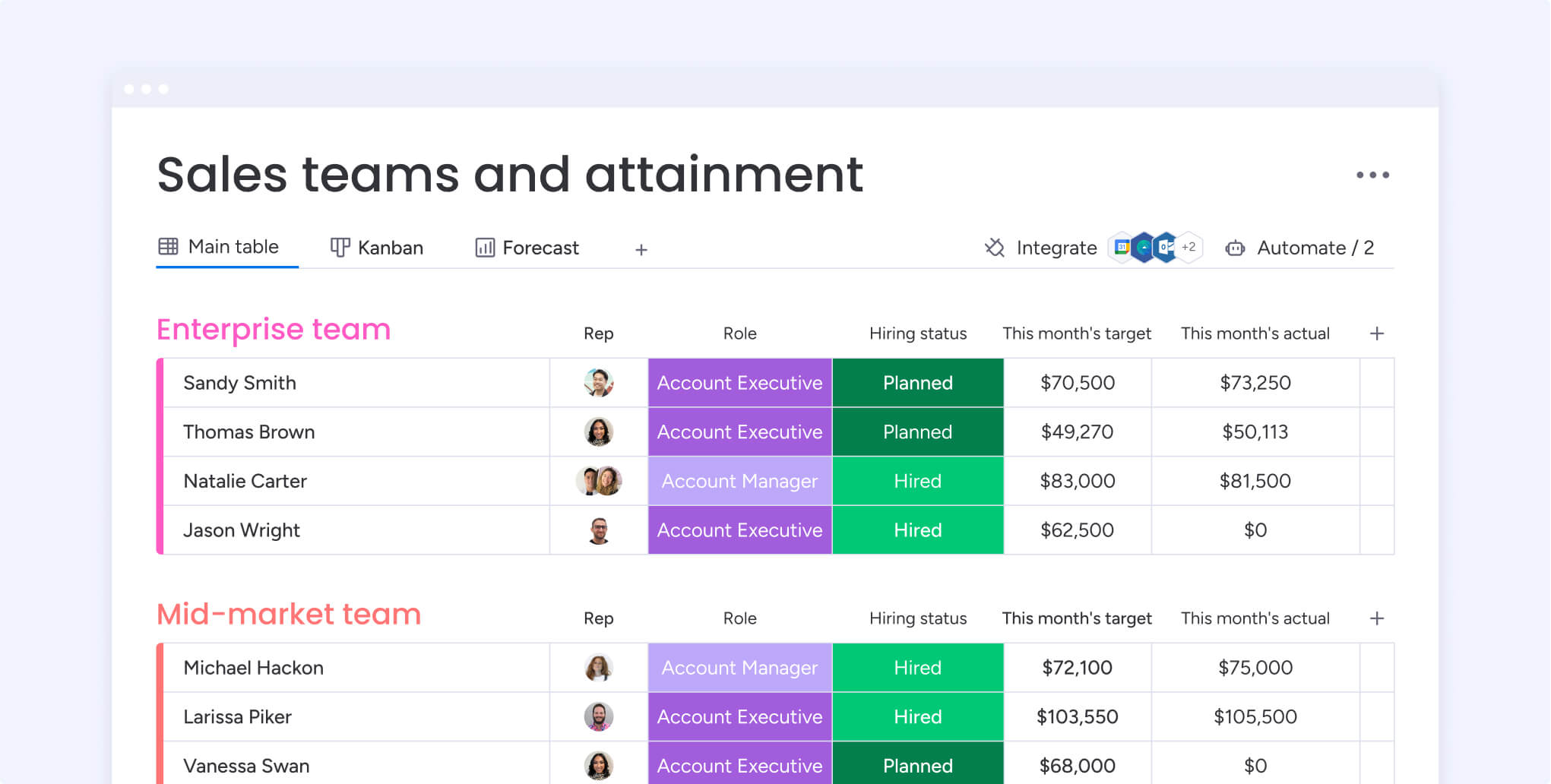
2. Integrated data
Connect all the apps and tools you already use — like Salesforce, Gmail, Outlook, Hubspot, Mailchimp, Twilio, Microsoft Teams, and more — to focus on the data that matters. No more working with endless screens and fields — save time by defining, collecting, and organizing the exact sales data you need to build your sales reports.
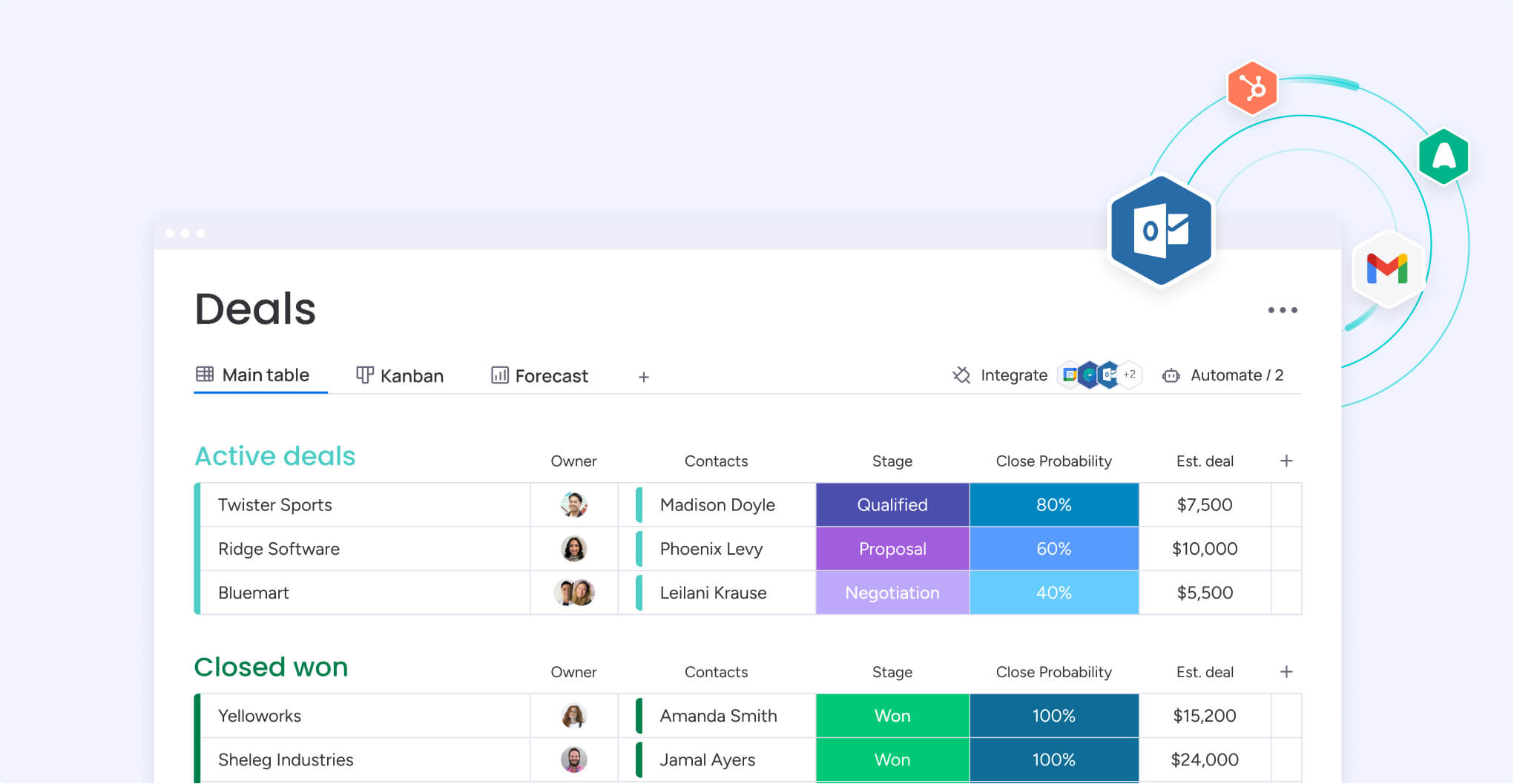
3. Automated boards
Workspaces in monday CRM come with pre-made boards for running the main components of a sales pipeline — leads, accounts, contacts, deals, activities, and sales dashboard.
These entity boards are already connected via automations. So, as sales reps make changes to elements within the sales pipeline, the board system syncs and adjusts accordingly and updates your custom dashboards and reports.
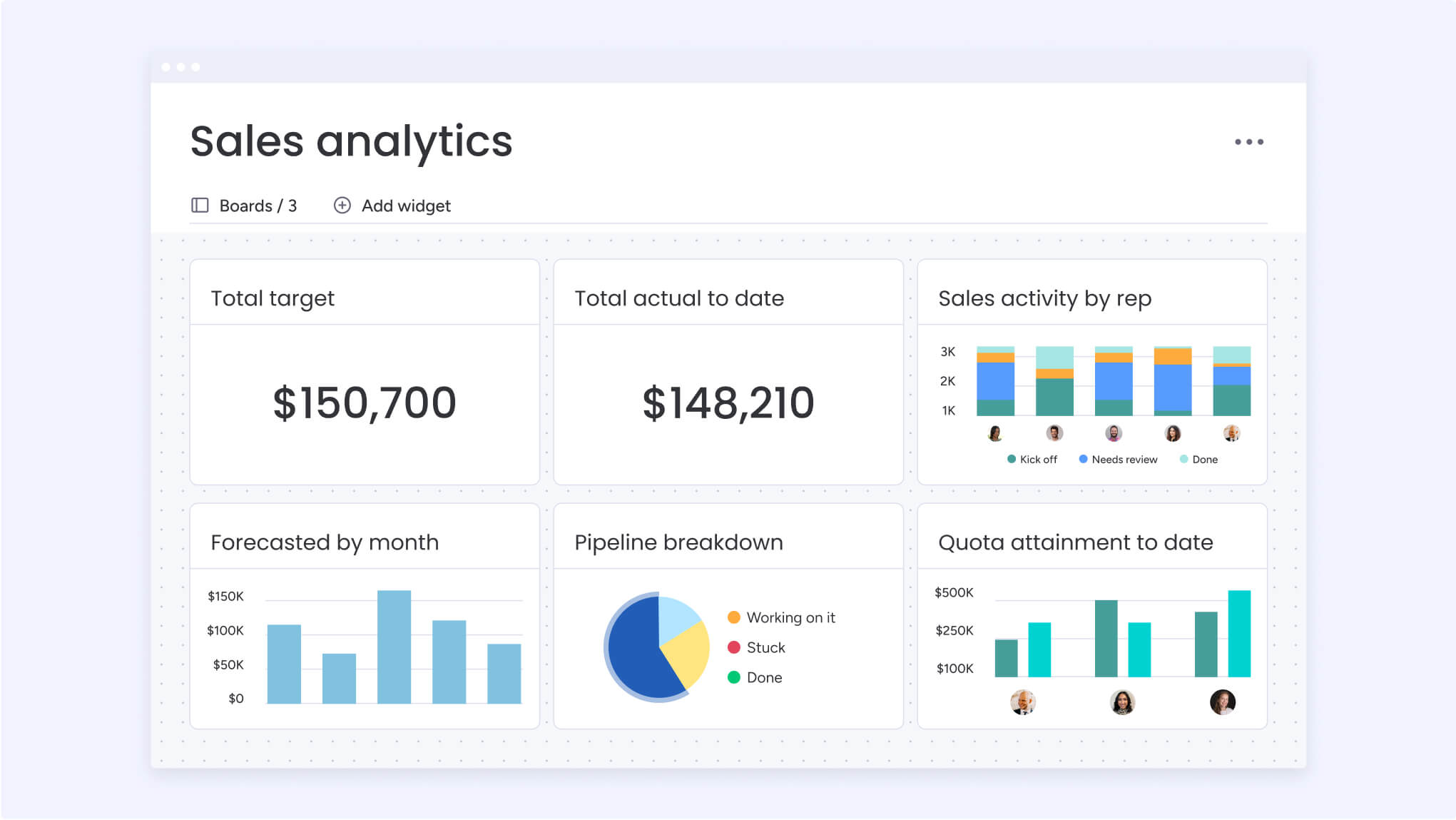
4. Custom dashboards
Instantly report your deal progress, sales figures, and team performance via the custom dashboards in monday CRM. For example, you could use a Funnel Chart to gain a better understanding of your pipeline conversion rates between different stages in the sales funnel. Or a Leaderboard to visualize and compare sales rep performance within each of their deal stages.
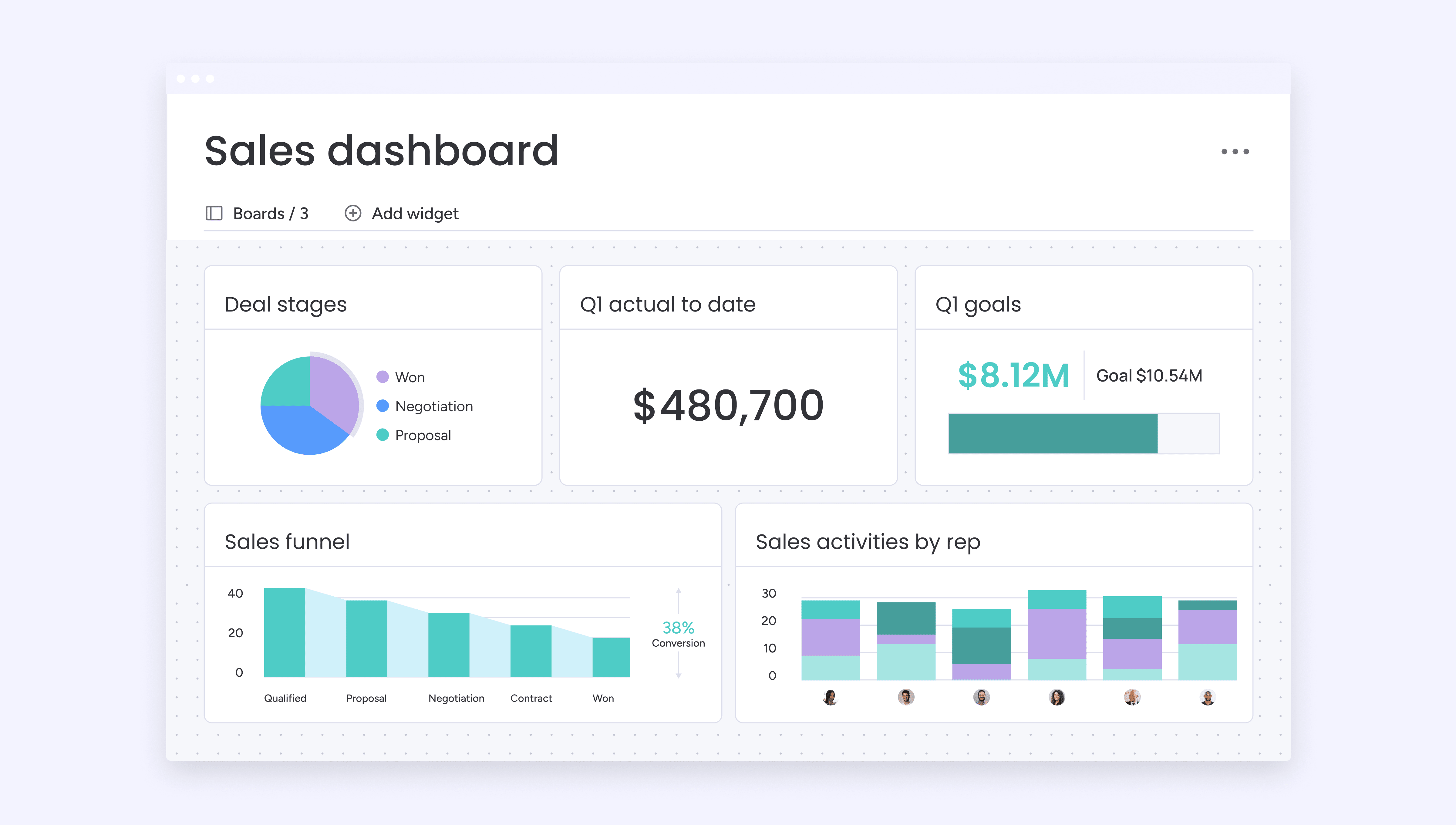
5. Drag-and-drop widgets
In monday CRM, you can see all your client information at a glance and document every interaction on the main CRM item page. Better still, you can enhance the board with various widgets, like the deal stage widget, to get a 360° view of your opportunities and clearly understand where each stands in your pipeline.
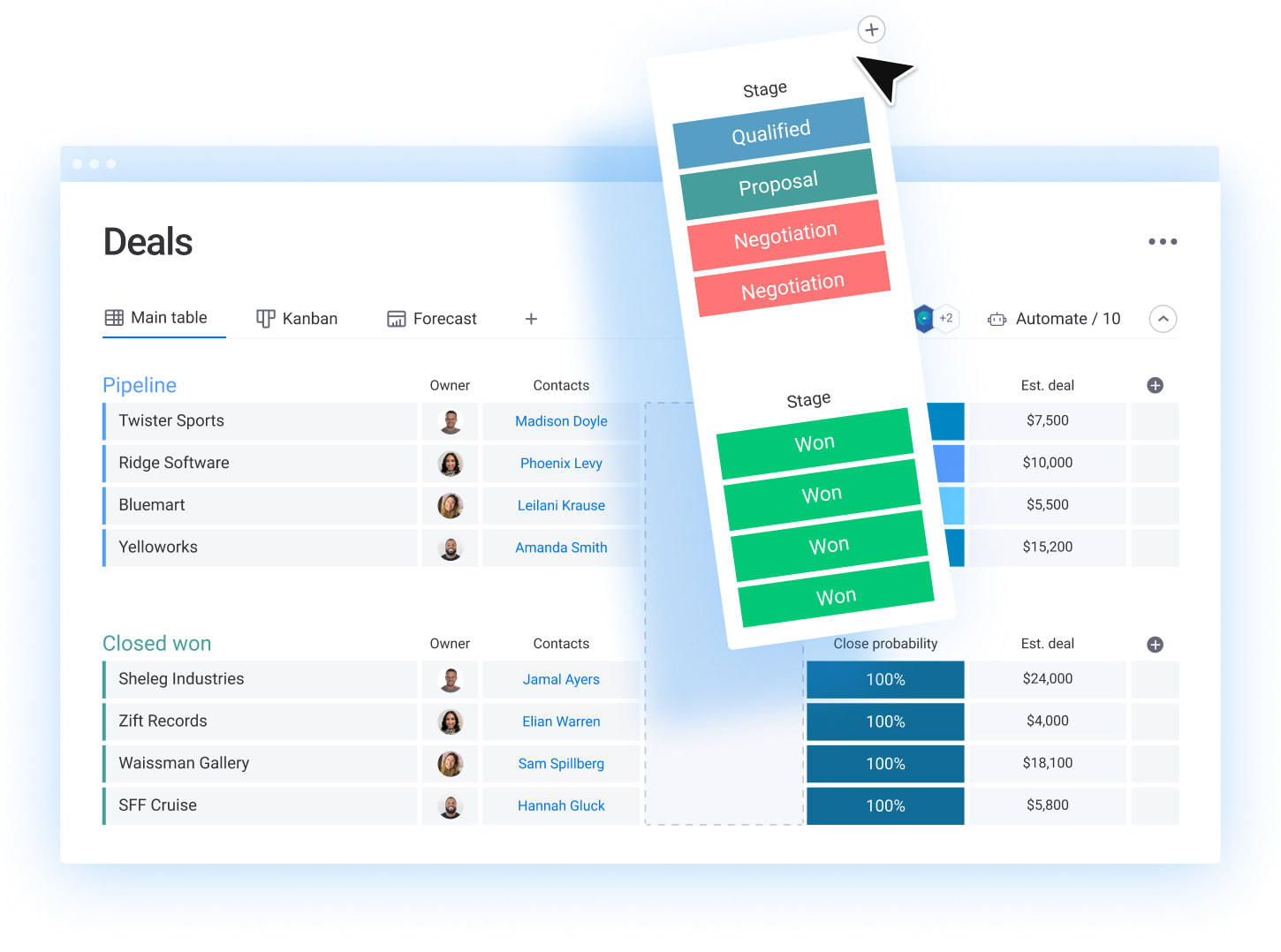
Start building data-driven and actionable sales reports
Creating well-structured, data-driven, and actionable sales reports will help your target audience make informed decisions that lead to improved sales performance and drive business growth.
Start building your sales reports in monday CRM today. Take advantage of the intuitive and customizable platform to collate, automate, and centralize your sales reports in one place so stakeholders can access the latest and most relevant data.
FAQs about sales reports
What is a sales report form?
A sales report form is another term for a sales report template. It provides a standardized way to present sales data for the reporting period and audience.
What are the different types of sales reports?
Some of the different types of sales reports include Revenue by salesperson, Conversion rate (Win-Loss report), Average sales cycle length, Actual vs. forecasted revenue report, Sales trends analysis report, and Daily/Weekly/Monthly/Quarterly/Annual sales report.
What is a sales activity report?
A sales activity report is a detailed document that provides an overview and analysis of a company's sales activities and performance over a specific time, such as daily, weekly, monthly, quarterly, or annual. Typical activities include the number of calls made, meetings held, proposals sent, deals closed, and revenue generated.
 Get started
Get started 
